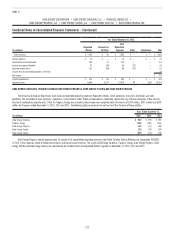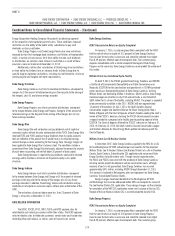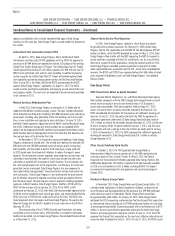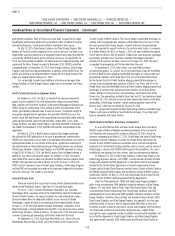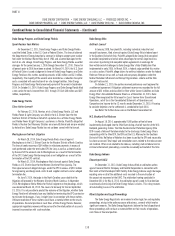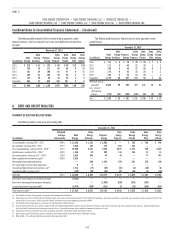Duke Energy 2015 Annual Report Download - page 150
Download and view the complete annual report
Please find page 150 of the 2015 Duke Energy annual report below. You can navigate through the pages in the report by either clicking on the pages listed below, or by using the keyword search tool below to find specific information within the annual report.
130
PART II
DUKE ENERGY CORPORATION • DUKE ENERGY CAROLINAS, LLC • PROGRESS ENERGY, INC. •
DUKE ENERGY PROGRESS, LLC • DUKE ENERGY FLORIDA, LLC • DUKE ENERGY OHIO, INC. • DUKE ENERGY INDIANA, INC.
Combined Notes to Consolidated Financial Statements – (Continued)
Grid Infrastructure Improvement Plan
On August 29, 2014, pursuant to a new statute, Duke Energy Indiana
filed a seven-year grid infrastructure improvement plan with the IURC with
an estimated cost of $1.9 billion, focusing on the reliability, integrity and
modernization of the transmission and distribution system. In May 2015, the
IURC denied the original proposal due to an insufficient level of detailed projects
and cost estimates in the plan. On December 7, 2015, Duke Energy Indiana filed
a revised infrastructure improvement plan with an estimated cost of $1.8 billion
in response to guidance from IURC orders and the Indiana Court of Appeals
decisions related to this new statute. The revised plan uses a combination
of advanced technology and infrastructure upgrades to improve service to
customers and provide them with better information about their energy use.
The plan is subject to approval of the IURC, with an order expected in July 2016.
Duke Energy Indiana cannot predict the outcome of this matter.
Other Regulatory Matters
Atlantic Coast Pipeline
On September 2, 2014, Duke Energy, Dominion Resources (Dominion),
Piedmont and AGL Resources announced the formation of a company, ACP, to
build and own the proposed Atlantic Coast Pipeline (the pipeline), a 564-mile
interstate natural gas pipeline. The pipeline is designed to meet the needs
identified in requests for proposals by Duke Energy Carolinas, Duke Energy
Progress and Piedmont. Dominion will build and operate the pipeline and has
a 45 percent ownership percentage in ACP. Duke Energy has a 40 percent
ownership interest in ACP through its Commercial Portfolio segment. Piedmont
owns 10 percent and the remaining share is owned by AGL Resources. Duke
Energy Carolinas and Duke Energy Progress, among others, will be customers of
the pipeline. Purchases will be made under several 20-year supply contracts,
subject to state regulatory approval. In October 2014, the NCUC and PSCSC
approved the Duke Energy Carolinas and Duke Energy Progress requests to enter
into certain affiliate agreements, pay compensation to ACP and to grant a waiver
of certain Code of Conduct provisions relating to contractual and jurisdictional
matters. On September 18, 2015, ACP filed an application with the FERC
requesting a CPCN authorizing ACP to construct the pipeline. ACP requested
approval of the application by July 1, 2016, to enable construction to begin by
September 2016, with an in-service date of on or before November 1, 2018.
ACP is working with various agencies to develop the final pipeline route. ACP
also requested approval of an open access tariff and the precedent agreements
it entered into with future pipeline customers, including Duke Energy Carolinas
and Duke Energy Progress.
On October 24, 2015, Duke Energy entered into a Merger Agreement
with Piedmont. The ACP partnership agreement includes provisions to allow
Dominion an option to purchase additional ownership interest in ACP to
maintain a leading ownership percentage. Any change in ownership interests
is not expected to be material to Duke Energy. Refer to Note 2 for further
information related to Duke Energy’s proposed acquisition of Piedmont.
Sabal Trail Transmission, LLC (Sabal Trail) Pipeline
On May 4, 2015, Duke Energy acquired a 7.5 percent ownership interest
from Spectra Energy in the proposed 500-mile Sabal Trail natural gas pipeline.
Spectra Energy will continue to own 59.5 percent of the Sabal Trail pipeline
and NextEra Energy will own the remaining 33 percent. The Sabal Trail pipeline
will traverse Alabama, Georgia and Florida to meet rapidly growing demand for
natural gas in those states. The primary customers of the Sabal Trail pipeline,
Duke Energy Florida and Florida Power & Light Company, have each contracted
to buy pipeline capacity for 25-year initial terms. On February 3, 2016, the FERC
issued an order granting the request for a CPCN to construct and operate the
pipeline. The Sabal Trail pipeline requires additional regulatory approvals and is
scheduled to begin service in 2017.
NC WARN FERC Complaint
On December 16, 2014, North Carolina Waste Awareness and Reduction
Network (NC WARN) filed a complaint with the FERC against Duke Energy
Carolinas and Duke Energy Progress that alleged (i) Duke Energy Carolinas
and Duke Energy Progress manipulated the electricity market by constructing
costly and unneeded generation facilities leading to unjust and unreasonable
rates; (ii) Duke Energy Carolinas and Duke Energy Progress failed to comply
with Order 1000 by not effectively connecting their transmission systems
with neighboring utilities which also have excess capacity; (iii) the plans of
Duke Energy Carolinas and Duke Energy Progress for unrealistic future growth
lead to unnecessary and expensive generating plants; (iv) the FERC should
investigate the practices of Duke Energy Carolinas and Duke Energy Progress
and the potential benefits of having them enter into a regional transmission
organization; and (v) the FERC should force Duke Energy Carolinas and Duke
Energy Progress to purchase power from other utilities rather than construct
wasteful and redundant power plants. NC WARN also filed a copy of the
complaint with the PSCSC on January 6, 2015. In April 2015, the FERC and the
PSCSC issued separate orders dismissing the NC WARN petition. On May 14,
2015, NC WARN filed with FERC a motion for reconsideration which the FERC
denied on November 19, 2015. This matter is now closed.
Progress Energy Merger FERC Mitigation
In June 2012, the FERC approved the merger with Progress Energy,
including Duke Energy and Progress Energy’s revised market power mitigation
plan, the Joint Dispatch Agreement (JDA) and the joint Open Access
Transmission Tariff. Several intervenors filed requests for rehearing challenging
various aspects of the FERC approval. On October 29, 2014, FERC denied all of
the requests for rehearing.
The revised market power mitigation plan provided for the acceleration
of one transmission project and the completion of seven other transmission
projects (Long-Term FERC Mitigation) and interim firm power sale agreements
during the completion of the transmission projects (Interim FERC Mitigation).
The Long-Term FERC Mitigation was expected to increase power imported
into the Duke Energy Carolinas and Duke Energy Progress service areas and
enhance competitive power supply options in the service areas. All of these
projects were completed in or before 2014. On May 30, 2014, the Independent
Monitor filed with FERC a final report stating that the Long-Term FERC Mitigation
is complete. Therefore, Duke Energy Carolinas’ and Duke Energy Progress’
obligations associated with the Interim FERC Mitigation have terminated. In the
second quarter of 2014, Duke Energy Progress recorded an $18 million partial
reversal of an impairment recorded in the third quarter of 2012. This reversal
adjusts the initial disallowance from the Long-Term FERC mitigation and reflects
updated information on the construction costs and in-service dates of the
transmission projects.
Following the closing of the merger, outside counsel reviewed Duke
Energy’s mitigation plan and discovered a technical error in the calculations.
On December 6, 2013, Duke Energy submitted a filing to the FERC disclosing
the error and arguing that no additional mitigation is necessary. The city of
New Bern filed a protest and requested that FERC order additional mitigation.
On October 29, 2014, FERC ordered that the amount of the stub mitigation
be increased from 25 MW to 129 MW. The stub mitigation is Duke Energy’s
commitment to set aside for third parties a certain quantity of firm transmission


